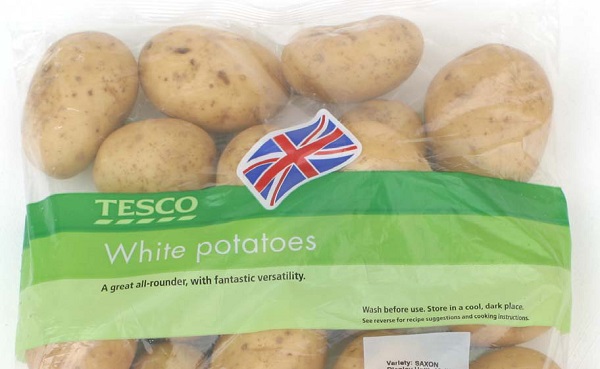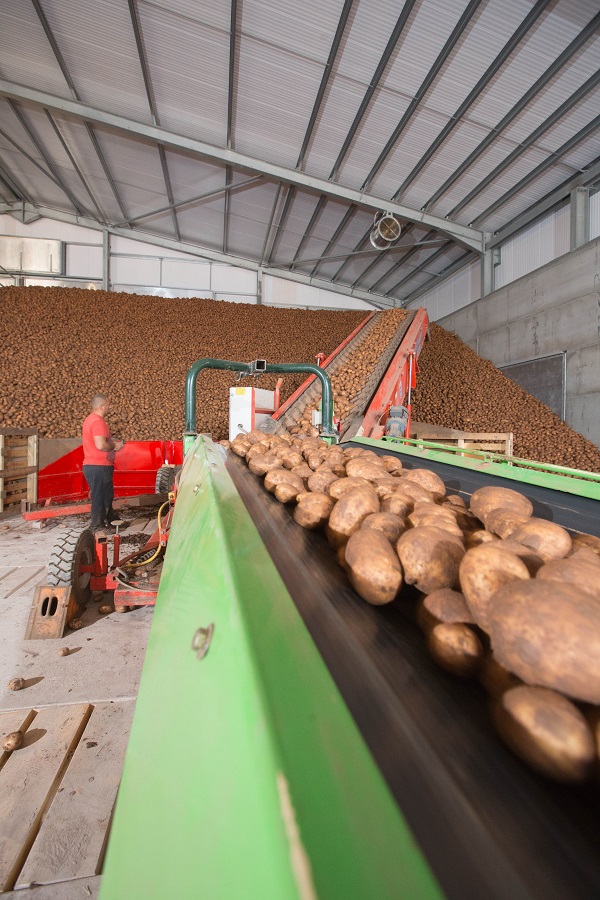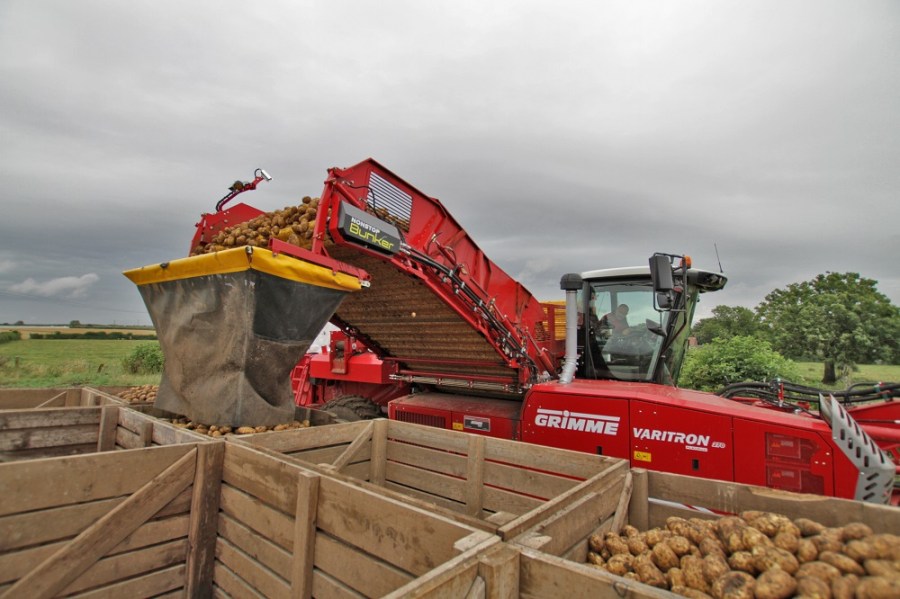Potato prices are the highest they’ve been for this time of year since 2013, so what does the season ahead hold? CPM finds out.
In the longer term, I can’t see prices falling far.
By Olivia Cooper
The new season potato campaign started on a high note this year, with strong old crop prices and tight stocks making for a bullish market. According to AHDB Potatoes, the GB planted area was 4% up on the year at 116,000ha, but that was still the second lowest area on record. And lower yields mean production could actually fall below the 2015 figure of 5.43M tonnes.
“If we have average yields that’ll more or less offset the increased area,” says Arthur Marshall, analyst at AHDB Potatoes. “But most farmers are reporting average yields at best.”

Although retail demand for fresh potatoes has been drifting in recent years, it improved marginally last year.
As of 17 Sept, farmers had lifted about 29,000ha – similar to the same time last year. Most remaining crops were senescing or had been burnt off, although those that hadn’t were reportedly suffering following the prolonged hot, dry conditions. “Crops are increasingly being lifted into stores, though there are some concerns over the high field temperatures possibly affecting storage quality,” he explains. “Yields are variable, with tuber counts generally on the low side.”
With the dry weather, bruising is a concern, with other waste mostly from growth cracks and greening. “There have been reports of growers delaying lifting, which could support prices in the short term.”
Indeed, although the GB weekly average price – which reached £268.50/t ex-farm in late June – followed the usual seasonal trend downwards as new crop lifting got under way, it rebounded in the week to 16 Sept, rising £2/t on the week to £167.12/t. The free-buy average also improved, gaining nearly £5/t to £185.30/t, although contract trade continued to make up most of the sample.
“In the longer term, I can’t see prices falling far – it would stand to reason that if we have similar production to last year then prices shouldn’t be too different,” he adds.

Yields are down and wastage is high so the market is expected to be firm.
One of the strongest sectors in the market remains packing whites, which drove prices up sharply in the spring and remains firm relative to other product areas. Although typically Maris Piper would command a premium to packing whites, that’s no longer the case, says Arthur Marshall. “Two years ago when the price was very low, people dropped packing whites and focussed on Maris Piper – the massive area cut from 2014 to 2015 was predominantly in packing white varieties.”
In 2015, the area of potatoes destined for packing fell by 11% to 38,000ha. That rebounded to 43,000ha this year, driven by high prices for best quality whites and baking potatoes in late 2015/16. However, while the overall area has increased, the general packing-white share remains smaller, leading to tight supplies against demand, he explains.
Plantings for the fresh chipping sector also increased this year, up 9% to the highest area since 2013, driven by stronger prices in 2015/16, says Amber Cottingham, analyst at AHDB Potatoes. “The seed-potato area also appears to have increased by 13% to about 17,000ha.” The area sown for processing increased slightly, whereas potatoes destined for fresh bags and ware both fell.
As of 16 Sept, free-buy demand for packing potatoes remained good, with best quality stocks in tight supply. Wholecrop Charlotte salads were fetching around £230/t ex-farm, with 45mm down Charlotte at £325-£395/t. Grade one reds were trading at £220-£270/t, with general pack Maris Piper at about £145/t. White baking varieties were priced at £240-£260/t, with grade one whites at £160-£230/t.
New Scottish packing supplies with correct skin set were limited, with some samples proving small with low baker content. Grade one Maris Piper and whites were fetching £190-£200/t, with 45mm down Maris Peer at £300-£320/t.
In the bagged sector, chipping prices were under pressure in mid-Sept, with demand subdued in some areas. In the East, Maris Piper for chipping remained firm at £140-£210/t ex-farm, with ware Marfona easing to £120/t in the West. “Bagged ware isn’t a huge part of the market now – the long-term trend is slowing,” says Arthur Marshall. In Scotland, low volumes of Isle of Jura were moving to Glasgow fruit market at £160/t.
Although retail demand for fresh potatoes has been drifting in recent years, it improved marginally last year, he adds. And despite last year’s small crop size, exports actually increased. “Exports aren’t so much associated with the surplus size – it’s more down to demand from importers.” By mid-Sept this year, shipments were under way to Ireland, the Canaries, Netherlands, the Faroe Islands and Belgium. Frying varieties to Ireland were trading at £140-£200/t, with ware to the Canaries at £210-£350/t, depending on variety.
So what about the UK’s competitors? According to Arthur Marshall, last year’s high prices encouraged growers to increase plantings in all the North-Western European Potato Growers (NEPG) countries (GB, France, Belgium, Netherlands and Germany). The total area was 4.8% up on last year, with Belgium showing a 12.5% increase. “However, yields are expected to be lower in all countries, suggesting production will be tighter than last year and below the five-year average,” he says.
The NEPG’s latest estimate put total production at 24.91m tonnes – 1.6% down on the year and 2.2% below the five-year mean. Processing yields have been good with high dry matter, but there’s been a lower proportion of large tubers. “Due to low yields and very dry soil conditions the harvest is behind schedule, with most of the potatoes still in the fields, which increases the risk of bad harvest conditions,” says the report.
“Potato prices on the free market are still quite firm after last season, and may be supported by the lower production this year,” it adds. “However, growers with contracts might have difficulties because of the lower yields and possible quality penalties, which causes lower profitability. This would also mean more demand from processors on the free market.”
So for growers with stocks in the barn, what does that mean for future price prospects? “In the short-term, there could be some harvest pressure,” explains Arthur Marshall. “But stocks got very tight last season and if supplies are down again it could be interesting come March/April time.”
Alan Birch at potato merchant Maincrop Potatoes reckons it’s still too early to confidently predict the market. “We’ll know more once the crop is in the barn. But yields are down and wastage is high so we’d expect that the market is going to be firm.”
In Yorks, wastage hasn’t been as high as in East Anglia, where some crops are losing 40-50% to growth cracks, says Chris Yardley, technical director at Wholecrop Marketing. “And I think we’ll have there or thereabouts an average yield.”
However, seed will be tighter than normal due to the poor growing season. “If controlled varieties are short it’ll make free varieties keener; I don’t think it’ll be cheaper than last year.”
Estima in particular is tight, although there are new varieties coming through, he adds. “Supermarkets are reducing their variety acceptance lists, which will take quite a few varieties out going forward, although they’ll have to be as good or better than traditional varieties.”
It’ll be interesting to see if buyers have to lower their quality acceptance standards, given the difficult year, says Chris Yardley. “If the price goes one way they’ll be more tolerant because there isn’t the spectrum on the Continent to fall back on.”
Although it’s still relatively early in the season, export demand to the Continent is good, he adds. “We’re exporting table as well as processing varieties, which we’ve never done before; there’s a good table market over there.”




